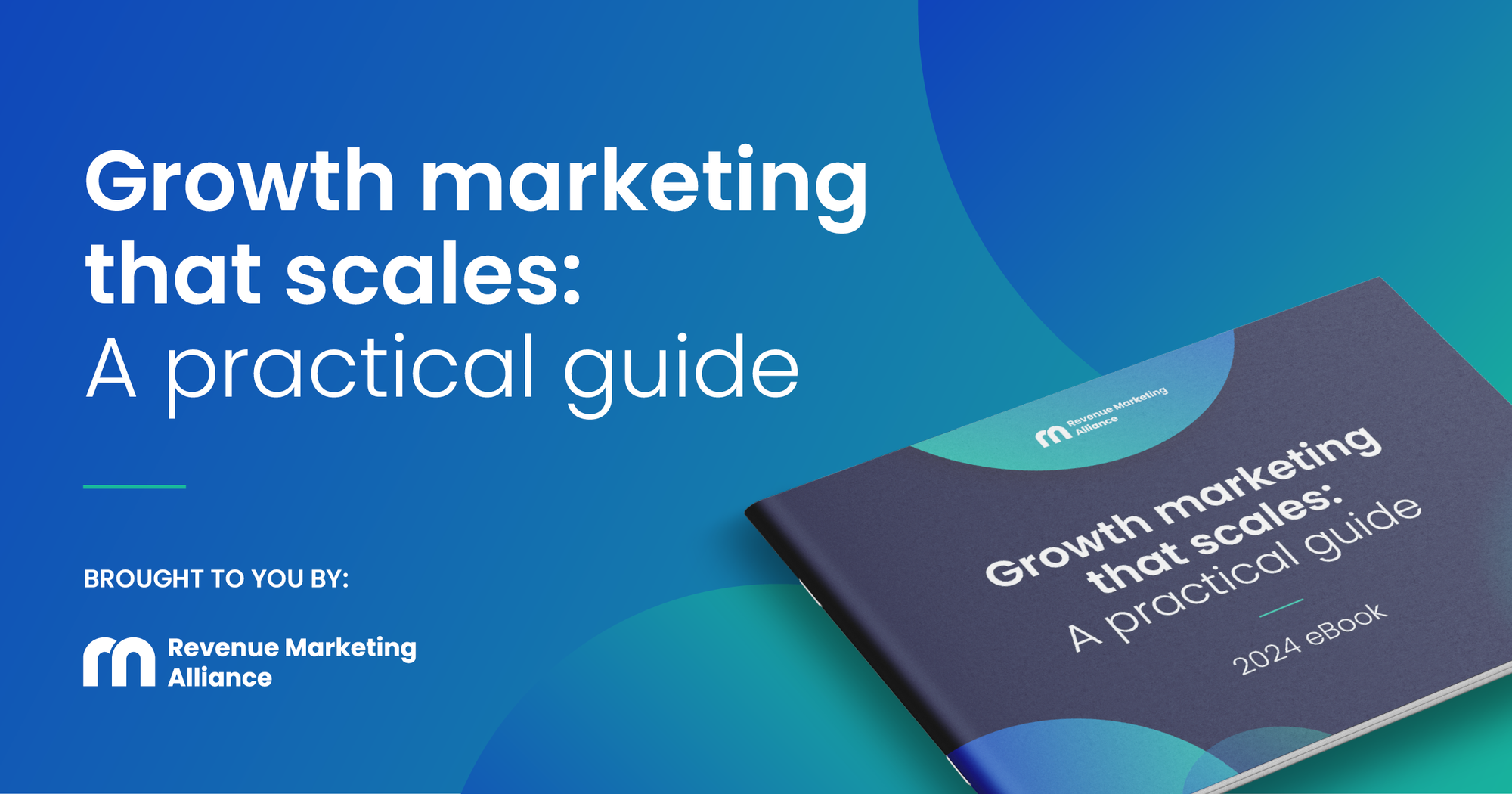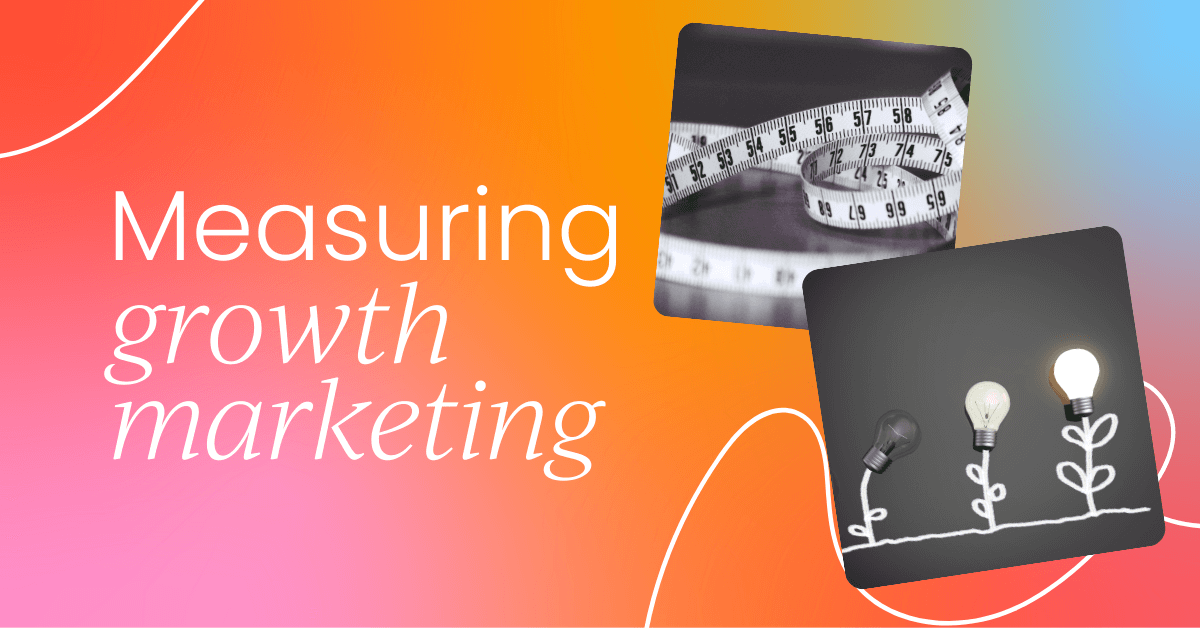Growth marketing thrives on data-driven decisions, not gut feelings. To consistently achieve your targets and fuel sustainable growth, you need to accurately measure and analyze your efforts.
This article explores the crucial process of tracking and evaluating your growth marketing strategies, allowing you to identify what works and what doesn't.
We'll focus on:
- Why measuring your growth marketing strategy is important
- Metrics to measure your growth marketing success
- Setting up analytics and measurement tools
- How to tackle attribution modeling
- How to calculate return on investment (ROI)
- How to continuously optimize and improve your efforts
- Best practices for communication and reporting
For marketers at any level, mastering these measurement methods is key to gaining a competitive edge and driving meaningful results.
Why measuring your growth marketing strategy is important
Measuring your growth marketing strategy is key for product marketers because it helps you see what's working to attract and keep customers, as well as boost revenue.
By tracking the right metrics, you can fine-tune your campaigns, make smarter decisions about where to focus your efforts, and adjust quickly to keep your product ahead of the competition.
Effectively, doing all of this makes sure that your marketing efforts stay aligned with business goals, leading to consistent and measurable growth.

Metrics to measure your growth marketing success
Measuring growth marketing success involves tracking a range of metrics that reflect the effectiveness of your strategies across different stages of the customer journey.
Here are some key ways to measure your growth marketing success:
1. Customer Acquisition Cost (CAC)
Customer acquisition cost (CAC) shows you how much it costs to gain a new customer. This includes factors such as marketing team salaries, advertising costs, and marketing software.
Calculation: Total cost of customer acquisition / Total number of new customers acquired.
CAC can help to determine if the customer lifetime value (more on this next) is within a healthy range. It may also show that it’s very expensive to acquire a new customer, which may indicate your current marketing efforts aren’t as successful as they could be. Or, it may mean your business should focus more on customer retention.
2. Customer Lifetime Value (CLTV or LTV)
Customer lifetime value tells you how much a customer is worth to you for the entire time they spend with your business. Many businesses make the mistake of only calculating how much they get from a customer from an initial sale, ignoring the value of a customer further down the line.
If you’re providing success for your customers, they should (hopefully) continue to do business with you for a longer period, buying more products and services - especially if your RPR is high.
So CLTV can be crucial in determining how successful your customers are and how much you can expect to earn from them - either annually, or over a longer timeframe. Knowing this data isn’t just important in making sure your product marketing strategy is on point, but can also help in forecasting and financial planning.
CLTV can give you two important pieces of information:
- The average length of a relationship with a customer.
- How much you can expect to earn from them per year (annual revenue).
To calculate the CLTV find out:
- What the annual revenue is from a customer
- How long you’ve been doing business with them
- How much it cost to acquire them
Once you’ve figured that out, you can:
- Multiply the annual rate per customer by the relationship length
- Then subtract the cost of acquiring them
This will tell you your customer lifetime value. One important thing to remember is that the CLTV for a customer can be fluid, as if you calculate it today, it might not have been the end of the relationship with that customer. Their value will have changed in a year’s time if you’re still doing business with them, so make sure to calculate it regularly.
3. Conversion rate
Conversion rate measures the percentage of leads that become paying customers. By tracking conversion rates, sales teams can identify areas to optimize their sales process and improve overall conversion rates. Or you, as the sales enablement specialist, can help them do so.
Conversion rates can also be tracked across each individual stage of the sales pipeline to more accurately pinpoint potential blockers within the sales funnel. This allows further insight into your sales processes.
Calculation: Number of conversions / Number of leads multiplied by 100.
Don’t be concerned if your conversion rate looks low - a healthy conversion rate is actually only around 2-5%. With only the most successful companies reaching a conversion rate of 20-25%.
If your conversion rate is looking particularly low, it might be time to look at sales processes and training to see where the problem lies.
4. Retention rate
Customer retention rate is a similar metric to repeat purchase rate, but is more applicable to businesses selling ongoing services, rather than one-off products.
Calculating retention rate gives you similar, useful information based on retaining service contracts rather than selling products repeatedly, although both can be used effectively no matter what your business model is.
Say if a business starts the year with 100 customers, but loses 25 along the way, it has a 75% retention rate. Of course, this doesn’t take into account new clients, which will in turn affect the overall retention rate.
In fact, the value of retention rate is so significant that it embodies an important fact in business: it is far cheaper to keep existing customers than to seek new ones. By increasing retention by merely 5%, you can expect to see profits ride from 25% to 95%. What’s not to like about those figures?
5. Churn rate
A high churn rate is a business’ nemesis and the antithesis to customer retention. A churn rate definition would essentially describe the number of people who stopped buying your product or subscribing to your service within any given period of time.
Calculating customer churn rate is a top priority for any product marketer. It’s an important metric to have under your belt, albeit not a particularly nice one if you discover you have a high churn rate. But by learning the mechanics of churn, you will be taking your first steps towards customer retention.
There are two different types of churn: voluntary and involuntary. A customer who involuntarily churned would be someone who stopped subscribing because they forgot to update their new credit card details and payment bounced.
Voluntary churn is when a client chooses to leave your business for a reason stemming from dissatisfaction with the product, price, or service.
To work out your churn rate, the formula is pretty simple: the number of customers lost in a period divided by the number of customers at the beginning of the period.
People churn for different reasons, so it’s a good idea to segment your groups by related reasons for churn. This way, when looking to reactivate churned users, you’ll gauge a more accurate reflection of what needs to be done for each customer.
6. Revenue growth rate
Revenue growth rate measures the percentage increase (or decrease) in a company’s revenue over a specific period, such as monthly, quarterly, or annually.
This metric is vital for assessing a company's financial health and growth trajectory. A consistent increase in revenue growth rate indicates successful market strategies, effective product positioning, and increasing customer acquisition and retention.
Calculation: ((Current Period Revenue - Previous Period Revenue) / Previous Period Revenue) x 100
For example, if the current period revenue is $1,200,000 and the previous period revenue is $1,000,000, the revenue growth rate would be: (($1,200,000 - $1,000,000) / $1,000,000) x 100 = 20%.
7. Net Promoter Score (NPS)
Your net promoter score (NPS) is a simple case of good minus bad.
When presented with a scale, ordinarily between 1-10, customers can choose a score that represents their likelihood of recommending your product or service to others.
You can break down the scores into categories of promoters (9-10), passives (6-8), and detractors (0-5). Just ask your customers the following: ‘On a scale of 0 to 10, how likely are you to recommend this product/company to a friend or colleague?’
- For those who vote 9-10, they’re your promoters. They’re the ones you want to nurture!
- Those who score between 6-8? They’re more of a passive customer who isn’t likely to recommend your brand.
- The dreaded detractors are categorized with a score 0-5 - you want to change this number ASAP.
To work out your net promoter score, you simply subtract the number of detractors from your promoters. You might be wondering about factoring the passives into all of this.
Well, that’s a good question, but ultimately if people feel that apathetically about your product or service, chances are they won’t bother spreading the word, whether it’s good or bad.

Setting up analytics and measurement tools
You can't improve what you don't measure, right? That's why setting up the right analytics and measurement tools is step one. These tools will give you the data you need to make informed decisions and prove the return on investment (ROI) of your marketing efforts.
Start by implementing an established web analytics platform like Google Analytics. It'll track everything from website traffic sources and user behavior to conversion rates and revenue data. Don't just set it and forget it, though. Spend time configuring goals, funnels, and custom event tracking to capture the metrics that matter to your business.
For campaigns across different channels, look into channel-specific analytics tools as well. Facebook Ads Manager, Google Ads, email marketing platforms, and customer relationship management (CRM) platforms like HubSpot all offer in-depth performance data you'll want to tap into.
When it comes to tools for data collection, startups, scaleups, and enterprise companies each have different needs based on their business size and resources.
Bad data in means bad insights out. So data accuracy and integrity should be a top priority.
Research from Gartner shows poor data quality costs organizations an average of $12.9 million annually. Regularly audit your tracking setup and clean your data to ensure you’re getting a clear picture.
Data cleaning techniques can look like this:
- Eliminating duplicate data.
- Removing irrelevant data, like tracking codes and HTML tags, for example.
- Making sure the text is consistent: Look out for mixed capitalization, no spaces between names, middle names, etc.
- Converting data types. For example, some data may be added as “01/01/24” vs. January 1st, 2024.
- Clearing formatting: If you’re taking data from multiple sources, there might be different formats depending on your sources or documents.
- Removing errors: Spelling mistakes or extra punctuation can mean you’re connecting with people who haven’t opted to be communicated with or you’re not actually reaching your customers.
Utilizing the right analytics and measurement tools can seriously help your growth marketing efforts. But you need to ensure your data is clean if you’re to garner real, valuable insights.
“Relying on data is key, but it's not always readily available in the right format. As a seasoned marketer, I've witnessed the frustration when data doesn't align with expectations or lacks clarity. That's why I emphasize the importance of regularly reviewing reports with the team and clarifying metrics.
“It's fantastic to see young marketers embracing a data-driven mindset, but without experience, interpreting data can be tricky. That's why fostering a culture of collaboration and open communication is crucial. By ensuring everyone understands the origins and limitations of the data, we can make informed decisions that drive growth.
“In my experience, not all metrics are interpreted the same way. That's why it's essential to have discussions and alignment sessions to ensure everyone is on the same page. By collectively understanding the nuances of the data, we can make smarter decisions and propel our growth marketing efforts forward.”
Britta Agel, Global Director of Marketing Strategy & Planning at Spryker
How to tackle attribution modeling
Once you've got your data in order, it's time to tackle attribution modeling. This is all about understanding which marketing touchpoints are contributing to conversions and revenue.
There are different attribution models out there from AI-based software, Facebook’s attribution tool, or the standard Google Analytics attribution models. They’re generally split into two main varieties: Single-touch and multi-touch.
Single-touch attribution
Single-touch attribution is like an old-school flip phone; it does the job, but you’re missing out on a lot of features.
Single-touch attribution models assign the credit of a conversion to a single, specific touchpoint in the buyer’s journey. While they’re simple to implement, they provide a limited view. Single-touch models might look like “first-touch,” “last-touch,” and “last non-direct touch.”
First-touch and last-touch attribution gives 100% of the credit to the first or last interaction a customer has with your business before converting. While a last non-direct touch attributes the credit to a specific source or asset before conversion, like an ad campaign, email, or newsletter.

Multi-touch attribution
Multi-touch attribution, on the other hand, is the smartphone of attribution models. It recognizes that a customer’s journey isn’t a single step but a series of interactions across different channels and platforms.
This type of attribution model gives you a deeper insight into the entire customer journey, providing a clear picture of the influence each touchpoint has had which has led to the final conversion. It lets you see which campaigns, channels, and tactics prove effective, which allows you to efficiently manage your marketing budget and optimize your campaigns.
Every customer interaction holds value. Marketing attribution helps you recognize that value, learn from it, and use it to guide your marketing efforts.
Don't just go with the default, though. Test out different models, analyze the impacts, and select the one that best aligns with your marketing and sales processes.
How to calculate return on investment (ROI)
Okay, you're tracking metrics, and you've got your attribution model nailed down – now it's time to prove your marketing ROI.
The goal of ROI is to make more money than you spend, but determining the ROI of your marketing campaigns can be tough because you’ll likely have different marketing tactics on the go at the same time.
If you’re using a pay-per-click (PPC) strategy, the platform you’re using may automatically calculate your ROI for you. However, when you look at the likes of content marketing, things get a little less clear.
For content, tracking URLs and other tech are on hand to help shed light on the advantages of content marketing, particularly when looking at growth and marketing qualified leads (MQLs).
Many organizations set their ROI benchmarks by looking at the return from similar tactics used in the past plus current sales numbers.
[((number of leads x lead-to-customer rate x average sales price) - cost or ad spend) ÷ cost or ad spend] x 100.
To use this formula, you need to first identify a few things:
- Number of leads: How many people converted to a lead?
- Lead-to-customer rate: What percentage of leads became a customer? If 12 out of 100 leads become a customer, your lead-to-customer rate would be 12% or 0.12.
- Average sales price: The average price of your product. An average can be helpful if you occasionally apply discounts or alter pricing in other ways.
- Cost of ad spend: How much did you spend on creating and promoting the marketing campaign? Here, you can factor in costs including ad spend, hourly wages of people who put time into the project, or costs related to producing content.
Don't forget to account for things like attribution windows, seasonality effects, and changing market conditions. Take into account non-financial factors, too. Things like social media engagement, website traffic, and even a feeling of increased customer satisfaction and loyalty have a hand in your marketing ROI.
"Spending more money on ads that deliver higher CTR or more leads is easy. To drive more impact though, invest in ads that deliver true SQLs or opportunities, even if that means sacrificing lead volume. This is where real growth happens."
Nick Mamouzellos, Director of Demand Generation EMEA at LRN
How to continuously optimize and improve your efforts
You know as well as we do, once you have your optimization all figured out, that’s just the beginning. Continuous improvement needs to be just that – continuous.
Make sure you’re always testing and improving. That’s how you ensure you’re grabbing any opportunities that arise; turning weaknesses into strengths and keeping on the never-ending path to growth.
Run A/B tests and multivariate experiments to fine-tune every aspect of creative messaging, audience targeting, offers, and incentives, you name it. Let the performance data guide you toward the highest-converting combinations.
But don't just test in isolation – look at the bigger picture, too. Maybe your Facebook ads are crushing it, but your landing pages are leaking conversions. Or perhaps your SEO is on point, but you're struggling with activation and retention down the funnel.
Constantly reevaluate your full-funnel customer journey. Use tools like on-site surveys, session recordings, and cohort analysis to identify drop-off points and areas of friction. Then take that qualitative and quantitative feedback to systematically improve the experience for your customers, and growth will follow.
"Data analysis and reporting can definitely help with campaign optimization and improvement. It is almost a given.
"Seeking constructive feedback from your product, sales, and customer success teams is not though. Be open (and not afraid) to receive your peers' qualitative opinions and thoughts across all levels to become better and deliver the results you need."
Nick Mamouzellos, Director of Demand Generation EMEA at LRN
Best practices for communication and reporting
If you want to maintain buy-in and keep those budgets flowing, you've got to communicate your marketing performance – and communicate it well: Dry reports and overwhelming data dumps just won't cut it.
Focus on telling a clear, compelling story with your reporting. Use visualizations to highlight key metrics and trends, and remember to provide context: Analyze root causes, and outline your optimization priorities.
Marketing requires cross-functional collaboration. So, when you’re communicating across different departments, make sure to tailor your messaging. Sales teams may care more about pipeline contribution, while executives want a high-level view of growth and ROI.
Speak their language and tell them what they need to hear.
Dare to be creative. Go beyond standard reports and dashboards; interactive presentations, data stories, and even video updates can be powerful communication tools in the right scenarios.
Framing your performance narrative thoughtfully and making data truly actionable is just as important as the insights themselves. It's how you'll cement yourself as a strategic, ROI-driven growth leader.
Final thoughts
Effectively measuring the success of your growth marketing strategies is vital for achieving sustainable results and continuous improvement.
Setting up helpful analytics tools, ensuring data accuracy, employing precise attribution models, and calculating your marketing ROI all work in tandem to provide you with valuable insights into your campaigns' performance.
Continuous optimization and a strategic approach to data analysis will empower you to make informed decisions, drive growth, and maintain a competitive edge.
Remember, the key to successful growth marketing lies not only in collecting data but in turning that data into actionable insights that propel your business forward.
Want to learn more about growth marketing?
We’ve got just the thing for you.
Growth marketing that scales: A practical guide is your no-nonsense handbook for scalable, repeatable growth that propels your business to new heights.
You'll gain a competitive edge by:
🎓 Mastering the core principles behind growth marketing
🎯 Developing a strong growth strategy
📊 Optimizing your marketing funnel
🔮 Creating tailored customer content And more, including real-world case studies from marketing pros!
Get your copy today. 👇




 Follow us on LinkedIn
Follow us on LinkedIn



